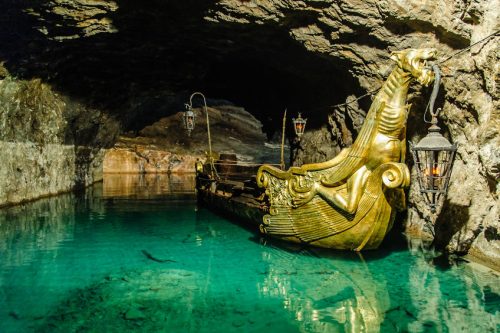Today, what was originally used by a miller as a gypsum mine in Lower Austria’s Hinterbrühl is a popular all-year-round excursion destination for all ages. The grotto (a show cave) is located about 15 km south of the city and is one of the top attractions near Vienna. The gypsum mining began in 1848 and continued until an explosion caused an inrush of water in 1912, which resulted in one of the most impressive natural monuments in the world: the largest underwater lake in Europe. Since then, 250,000 people have visited Seegrotte Hinterbrühl every year.
Seegrotte Hinterbrühl

Purpose in the Second World War: Aircraft factory
The abandoned mine was bought by Friedrich Fischer, who tried to use it for growing mushrooms, however, this was not possible due to the low temperatures there. Afterwards, he found success in pursuing his original idea for an entertainment establishment: the show mine was opened on the 8th June, 1932 and until the Second World War, it had already achieved clear recognition, with approx. 50,000 guests in 1937/1938.
In addition to its show operations, it then began its use for storing technical fats and cultural assets to protect these from bomb attacks and in 1944, the mining galleries were seized. The galleries were pumped out, drained, and heated – and from that point on, airplanes were built there, which were then conveyed outside and transported to Vienna Airport in Schwechat in disassembled parts, where they were then reassembled. The work was carried out by prisoners from the Mauthausen Concentration Camp, and a memorial still commemorates them today.
It was not until 1984 that the grotto was allowed to be used for visits again. In the same year, the lake grotto was finally once again in the ownership of the Fischer family.
Visits with a guided tour through the lake grotto
Seegrotte Hinterbrühl consists of 2 levels. To get to the upper level, you can take stairs through a headrace tunnel. Here, you will not only see how gypsum was mined and view the break chamber, St. Barbara’s Chapel, and the stables, but there is also an airplane model, museum, incline ramp, and tower, as well as a festival room and the small blue lake.
The lower level lies approx. 60 metres below the earth’s surface and with approx. 6,200m² of water area, forms Europe’s largest underwater lake. A huge volume of water enters the lake by way of altogether 7 tributaries every day. For this reason, 50-60,000 litres of water are pumped out every night to keep the water level at a constant 1.20 metres. You can experience a guided tour over the crystal-clear water in a boat.
Film set of the Three Musketeers
One special feature since the beginning of the 1990s has been the dungeon. It has no historical background, but was used as the backdrop for several scenes of the Hollywood film “The Three Musketeers”, starring Charlie Sheen and Kiefer Sutherland.
Guided tours
Duration of a tour including boat trip: approx. 45 minutes (waiting time approx. 20 minutes)
The constant temperature of approx. 9 degrees Celsius is kept all year round. It is recommended you take a jacket even in summer!
How to reach the Seegrotte
Address: Grutschgasse 2a, 2371 Hinterbrühl
Public transport: Bus line 262, stop: Hinterbrühl Beethovengasse (10-11 minutes by foot), Vorderbrühl Husarentempelgasse (9 minutes by foot), or stop: Gaadner Straße Mitte (10 minutes by foot).
Map:
Sie sehen gerade einen Platzhalterinhalt von Standard. Um auf den eigentlichen Inhalt zuzugreifen, klicken Sie auf den Button unten. Bitte beachten Sie, dass dabei Daten an Drittanbieter weitergegeben werden.
Mehr InformationenFurther information on the experience



